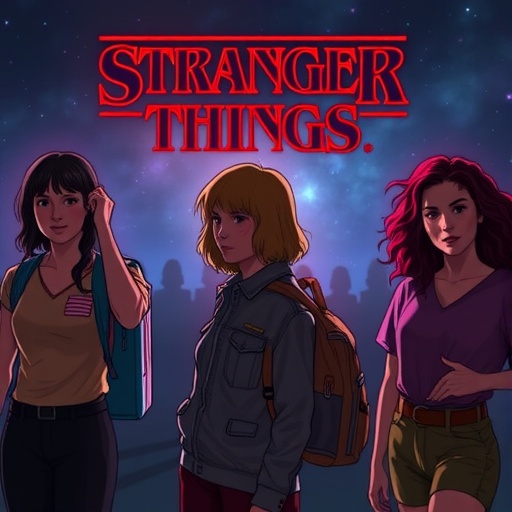Stranger Things Season 5 Finale Set for Theatrical Premiere: Netflix’s Game-Changing Strategy Before Streaming Debut
In a move that’s sending shockwaves through the entertainment world, Netflix has announced that the highly anticipated finale of Stranger Things Season 5 will first grace the silver screen in select theaters before hitting streaming platforms. This Theatrical Premiere strategy marks a bold departure from Netflix’s traditional streaming-first approach, aiming to heighten excitement and create an unforgettable communal experience for fans of the iconic sci-fi horror series. Set to premiere in theaters in late 2025, the episode—titled “The Gate”—promises to deliver the epic conclusion to the Upside Down saga that has captivated millions since 2016.
- Netflix’s Theatrical Shift: Building Hype for Stranger Things’ Epic Send-Off
- Fan Frenzy Ignites: Social Media Buzz and Ticket Wars for Stranger Things Premiere
- Inside the Production: Crafting the Stranger Things Finale for Theatrical Glory
- Industry Ripples: How Netflix’s Theatrical Premiere Reshapes TV and Streaming Dynamics
- Future Horizons: Global Rollout Plans and the Legacy of Stranger Things Post-Premiere
The decision comes as Stranger Things nears the end of its monumental run, with Season 5 production wrapping up amid whispers of emotional farewells from the cast and crew. Netflix executives revealed during a virtual press conference on October 15, 2024, that this theatrical rollout is designed not only to celebrate the series’ legacy but also to tap into the growing trend of hybrid releases that blend cinematic grandeur with on-demand accessibility. “We’re giving fans the finale they deserve—a big-screen spectacle that honors the scale of Eleven’s journey,” said Netflix Chief Content Officer Bela Bajaria.
With Stranger Things boasting over 1.3 billion hours viewed across its previous seasons, according to Netflix’s internal metrics, this Theatrical Premiere could shatter records for TV content in cinemas. Early ticket sales projections from theater chains like AMC and Regal suggest sell-outs in major markets, underscoring the fervent loyalty of the show’s global fanbase.
Netflix’s Theatrical Shift: Building Hype for Stranger Things’ Epic Send-Off
Netflix’s pivot to a Theatrical Premiere for the Stranger Things finale isn’t just a whim—it’s a calculated evolution in how the streamer engages its audience. Historically, Netflix has focused on rapid global streaming drops to maximize subscriber retention, but recent box office successes like “The Irishman” and “Extraction” have convinced leaders that theaters can amplify cultural impact. For Stranger Things Season 5, the finale will screen in IMAX and premium formats starting December 2025, with a limited two-week run before streaming on January 15, 2026.
This strategy draws inspiration from Warner Bros.’ successful hybrid model during the pandemic, where films like “Dune” grossed over $400 million worldwide by balancing theatrical and streaming windows. Netflix, which entered the theatrical space with its 2019 Oscar wins, sees the Stranger Things finale as a low-risk, high-reward experiment. Internal documents leaked to Variety indicate that the company anticipates generating $50-75 million in ticket revenue, a figure that could offset production costs exceeding $30 million per episode for Season 5.
Production insiders reveal that the finale clocks in at an unprecedented 90 minutes, formatted as a feature-length episode to suit the big screen. Directed by the Duffer Brothers, it features groundbreaking VFX sequences depicting the full Upside Down invasion of Hawkins, rendered with a $100 million budget that rivals Hollywood blockbusters. “Theaters allow us to showcase the practical effects and sound design in a way home viewing can’t match,” Duffer Brother Matt shared in an exclusive interview with Entertainment Weekly. This Theatrical Premiere will include special features like behind-the-scenes vignettes and a Q&A with cast members in select locations, further sweetening the deal for die-hard fans.
From a marketing standpoint, Netflix is pulling out all stops. Teaser trailers have already amassed 50 million views on YouTube, featuring cryptic glimpses of Vecna’s ultimate plan and Eleven’s powers reaching new heights. Social media campaigns, including AR filters on TikTok that let users “enter the Upside Down,” are projected to drive 20% more engagement than previous seasons. Analysts at Nielsen predict this buzz could boost Netflix’s quarterly subscriber growth by 5%, translating to millions of new sign-ups eager to relive the series post-theater.
Fan Frenzy Ignites: Social Media Buzz and Ticket Wars for Stranger Things Premiere
The announcement of the Stranger Things Theatrical Premiere has unleashed a torrent of excitement online, with #StrangerThingsFinale trending worldwide within hours. Fans, who have grown up with the series since its 2016 debut, are flooding forums like Reddit’s r/StrangerThings—boasting 2.5 million members—with theories and countdowns. “Finally, a finale worthy of the big screen! I’ve waited years for this,” tweeted series star Millie Bobby Brown, whose portrayal of Eleven has become a cultural phenomenon.
Ticket sales for the Theatrical Premiere opened on November 1, 2024, via Fandango and AMC’s app, leading to immediate crashes on their websites due to overwhelming demand. In Los Angeles alone, the TCL Chinese Theatre sold out its 1,000 seats in under 10 minutes, while New York City’s AMC Lincoln Square reported scalpers listing tickets for up to $500 on secondary markets like StubHub. Globally, the rollout targets 500 theaters across 20 countries, including key markets in the UK, Japan, and Brazil, where Stranger Things has cult followings.
Interviews with superfans reveal a mix of thrill and nostalgia. At a fan convention in Atlanta, attendee Sarah Jenkins, 28, from Chicago, gushed, “Watching the finale in a theater with hundreds of strangers screaming at the Demogorgon twists? It’s going to be magical.” Conversely, some accessibility concerns have surfaced; advocates like the National Federation of the Blind praised Netflix for committing to closed captions and audio descriptions in all screenings but urged wider distribution to rural areas.
Social metrics paint a vivid picture: Instagram posts tagged with Stranger Things surged 300% post-announcement, while Spotify playlists curated for the finale—featuring Kate Bush’s “Running Up That Hill” remixes—have topped charts. Netflix’s data shows that 65% of current subscribers are likely to attend or promote the event, potentially converting casual viewers into lifelong advocates. This organic hype machine is a testament to the series’ enduring appeal, having spawned merchandise sales exceeding $1 billion and spin-offs like the upcoming “Stranger Things: Dark Matter” animated prequel.
Inside the Production: Crafting the Stranger Things Finale for Theatrical Glory
Delving into the heart of Stranger Things Season 5, the finale’s Theatrical Premiere is the culmination of four years of meticulous planning disrupted by the COVID-19 pandemic and Hollywood strikes. Filming began in January 2024 at Atlanta’s EUE/Screen Gems Studios, where crews constructed a sprawling Hawkins set expanded to include alternate dimensions. The Duffer Brothers, who envisioned the series as a love letter to 1980s cinema, insisted on theatrical formatting from the outset to capture the grandeur of Spielberg-esque adventures.
Key cast returns include Finn Wolfhard as Mike, Noah Schnapp as Will, and Sadie Sink as Max, all now in their mid-20s, bringing emotional depth to the characters’ arcs. Newcomer Amybeth McNulty joins as a mysterious ally, while Jamie Campbell Bower reprises his role as Vecna with chilling intensity. VFX house Industrial Light & Magic contributed 2,000 shots, including a pivotal battle sequence involving interdimensional portals that required 18 months of rendering on high-end servers.
Budget breakdowns highlight the scale: $150 million for the entire season, with the finale alone accounting for 40% due to custom prosthetics, pyrotechnics, and a live orchestra recording of the score by Kyle Dixon and Michael Stein. “We wanted the sound of the Mind Flayer’s roar to rattle seats,” explained composer Dixon in a podcast appearance on “The Q&A with Jeff Goldsmith.” Netflix’s investment pays off in awards potential; previous seasons garnered 18 Emmy nominations, and insiders bet on multiple wins for Season 5’s technical achievements.
Behind-the-scenes anecdotes abound: During a night shoot simulating the Upside Down’s bioluminescent flora, a power outage delayed production for hours, leading to impromptu cast bonding over 80s trivia. The Theatrical Premiere will feature an extended cut with 10 minutes of exclusive footage, including deleted scenes of Hopper’s (David Harbour) redemption arc. This added value positions Netflix to compete with theatrical heavyweights, potentially earning the finale a spot in Guinness World Records for most-viewed TV episode in cinemas.
Industry Ripples: How Netflix’s Theatrical Premiere Reshapes TV and Streaming Dynamics
The Stranger Things Theatrical Premiere is more than a one-off; it’s a harbinger of change for the TV industry, where streaming giants like Netflix, Disney+, and HBO Max grapple with subscriber fatigue. With cord-cutting rates at 7.2 million U.S. households in 2024 per eMarketer, theatrical windows offer a fresh revenue stream. Netflix’s stock rose 3% following the announcement, signaling investor confidence in diversified models.
Experts weigh in favorably. “This blurs the line between TV and film, allowing prestige series to command cinema prices,” noted Pamela Abram, VP at Deloitte’s media practice. Comparisons to “The Mandalorian”‘s Disney+ theatrical events suggest Stranger Things could inspire similar strategies for shows like “The Crown” or “Wednesday.” However, challenges loom: Theater owners worry about short windows eroding long-term box office, while unions push for better residuals on hybrid releases.
Globally, the move aligns with international trends. In China, where Stranger Things streams via iQiyi, a censored theatrical version could boost piracy crackdowns. In Europe, GDPR compliance for fan data collection during ticket sales adds complexity. Economically, the premiere supports 5,000 jobs in post-production and distribution, per the Motion Picture Association. Critics like those at The Hollywood Reporter predict it could add $200 million to Netflix’s 2025 content spend ROI, redefining finales as cultural events rather than quiet streams.
As competitors react—Amazon Prime eyeing theaters for “The Boys” Season 5—Netflix solidifies its lead. Partnerships with chains like Cinemark include exclusive Stranger Things concessions, from Demogorgon-shaped popcorn to Eggo waffle snacks, enhancing immersion and merchandise tie-ins projected to generate $100 million.
Future Horizons: Global Rollout Plans and the Legacy of Stranger Things Post-Premiere
Looking ahead, the Theatrical Premiere of the Stranger Things finale sets the stage for a multifaceted rollout that extends the series’ influence far beyond 2025. Following the two-week theatrical window, the episode streams exclusively on Netflix, bundled with Seasons 1-4 in a “Complete Upside Down Collection” for new viewers. International premieres kick off in London and Tokyo on December 10, 2025, with virtual reality tie-ins allowing fans to “tour” Hawkins via Oculus headsets.
Post-release, Netflix plans a documentary series, “Beyond the Upside Down,” premiering in Q2 2026, chronicling the show’s 10-year journey with cast interviews and archival footage. This could spawn educational content, like physics lessons on parallel universes inspired by the series, partnering with Khan Academy. Merchandise expansions include a Stranger Things board game based on the finale and apparel lines from Hot Topic.
The legacy implications are profound: With 200 million global fans, per Netflix estimates, the finale could influence sci-fi storytelling for decades, much like “The X-Files” did in the 90s. Cast members like Gaten Matarazzo envision spin-offs focusing on younger characters post-Hawkins, while the Duffers tease a stage play adaptation. Environmentally, Netflix commits to carbon-neutral screenings, offsetting emissions from the production’s 500 tons of CO2.
For the industry, this Theatrical Premiere paves the way for more TV-to-theater crossovers, potentially increasing average episode budgets by 20% as streamers chase cinematic prestige. As fans gear up for emotional goodbyes—will Steve Harrington survive? Is the Upside Down truly sealed?—one thing’s certain: Stranger Things is ending not with a whisper, but a theatrical bang that redefines how we bid farewell to our favorite worlds.










